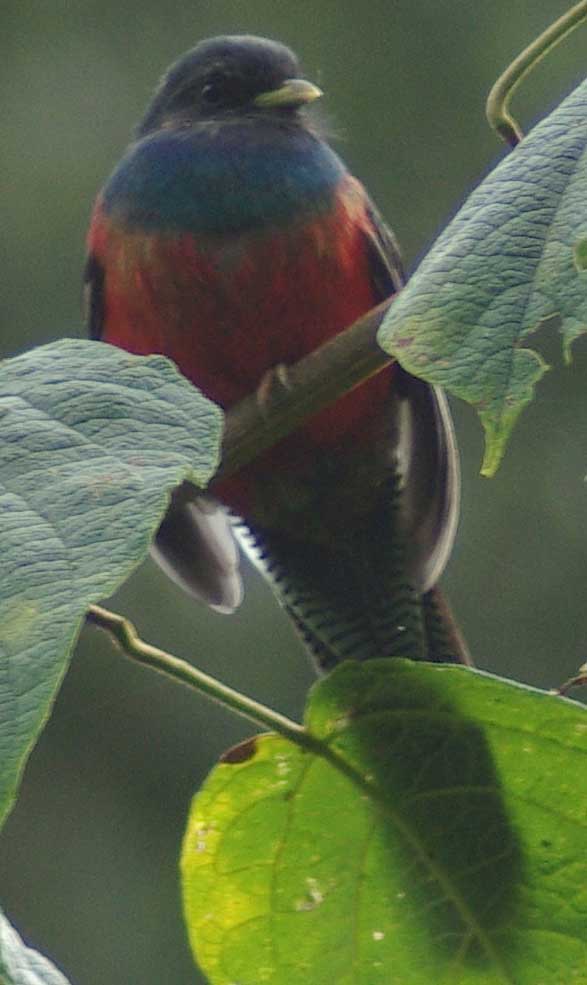
Apaloderma vittatum (*)
Superregnum: Eukaryota
Cladus: Unikonta
Cladus: Opisthokonta
Cladus: Holozoa
Regnum: Animalia
Subregnum: Eumetazoa
Cladus: Bilateria
Cladus: Nephrozoa
Superphylum: Deuterostomia
Phylum: Chordata
Subphylum: Vertebrata
Infraphylum: Gnathostomata
Megaclassis: Osteichthyes
Cladus: Sarcopterygii
Cladus: Rhipidistia
Cladus: Tetrapodomorpha
Cladus: Eotetrapodiformes
Cladus: Elpistostegalia
Superclassis: Tetrapoda
Cladus: Reptiliomorpha
Cladus: Amniota
Classis: Reptilia
Cladus: Eureptilia
Cladus: Romeriida
Subclassis: Diapsida
Cladus: Sauria
Infraclassis: Archosauromorpha
Cladus: Crurotarsi
Divisio: Archosauria
Cladus: Avemetatarsalia
Cladus: Ornithodira
Subtaxon: Dinosauromorpha
Cladus: Dinosauriformes
Cladus: Dracohors
Cladus: Dinosauria
Ordo: Saurischia
Cladus: Eusaurischia
Subordo: Theropoda
Cladus: Neotheropoda
Cladus: Averostra
Cladus: Tetanurae
Cladus: Avetheropoda
Cladus: Coelurosauria
Cladus: Tyrannoraptora
Cladus: Maniraptoromorpha
Cladus: Maniraptoriformes
Cladus: Maniraptora
Cladus: Pennaraptora
Cladus: Paraves
Cladus: Eumaniraptora
Cladus: Avialae
Infraclassis: Aves
Cladus: Euavialae
Cladus: Avebrevicauda
Cladus: Pygostylia
Cladus: Ornithothoraces
Cladus: Ornithuromorpha
Cladus: Carinatae
Parvclassis: Neornithes
Cohors: Neognathae
Cladus: Neoaves
Ordo: Trogoniformes
Familia: Trogonidae
Genus: Apaloderma
Species: Apaloderma vittatum
Name
Apaloderma vittatum Shelley, 1882
References
Proceedings of the Zoological Society of London Pt2 p. 306
Vernacular names
Afrikaans: Bandstertbosloerie
English: Bar-tailed Trogon
Esperanto: Strivosta trogono
español: Trogón montano
français: Trogon à queue barrée
Kiswahili: Lukungu Mkia-miraba
The bar-tailed trogon (Apaloderma vittatum) is a species of bird in the family Trogonidae. It is a resident bird to central Africa that eats primarily insects and fruits.
Description
The bar-tailed trogon averages about 28 centimetres (11 in) long. The bill and feet are yellow, and the tail, long and broad as usual for trogons, has the underside narrowly barred with black and white. The male's head is blue-black with bronze iridescence. Below the eye are two yellow or orange patches of bare skin; above the eye is a yellow or grey patch. The upper breast is iridescent from violet to blue-green; the rest of the underparts are red. The back is green and the upper surface of the tail is blue-black or purple-black. The female's head is brown with less ornamental bare skin and its throat and breast are light cinnamon; otherwise it resembles the male. The immature is similar to the female, but has a white belly and pale spots on the wings formed by the tips of the wing coverts and inner secondaries.[2]
The vocalisations are described as a yelping crescendo, "yaow, yow, yow, yow… or wuk-wuk-wuk-wuk…." The female gives "a whining chee-uu."[2]
Dickcissel male perched on a metal pole singing, with neck stretched and beak open.
Songs and calls
Listen to Bar-tailed trogon on xeno-canto
Distribution and habitat
The bar-tailed trogon is found in Angola, Burundi, Cameroon, the Congo, Equatorial Guinea, Kenya, Malawi, Mozambique, Nigeria, Rwanda, Tanzania, Uganda, and Zambia.[1] It lives in forests; at altitudes between 900 to 3,000 m (3,000 to 9,800 ft),[3] is typically higher than that of the Narina trogon, but the two occur together in some places.[2]
Behavior
Feeding
The bar-tailed trogon, similar to other trogons, feeds on insects and fruits.[4]
Breeding
The bar-tailed trogon breeding season occurs as the dry season ends at the rainy season begins (October and November).[5] Yearlings are not known to mate or hold territories; however, there have been reports of them singing.[6]
Conservation
The IUCN classifies the bar-tailed trogon as Least Concern but the species is experiencing a decreasing trend due to habitat destruction.[3]
Gallery
Adult male at Bwindi, western Uganda
Adult male at Bwindi, western Uganda
Illustration by Keulemans, 1892
Illustration by Keulemans, 1892
Subadult, potentially male; Kenya.
Subadult, potentially male; Kenya.
References
BirdLife International (2016). "Apaloderma vittatum". IUCN Red List of Threatened Species. 2016: e.T22682723A92958220. doi:10.2305/IUCN.UK.2016-3.RLTS.T22682723A92958220.en. Retrieved 13 November 2021.
Zimmerman, Dale A.; Donald A. Turner & David J. Pearson (1999). Birds of Kenya and Northern Tanzania. Princeton University Press. pp. 134–135, 386. ISBN 0-691-01022-6.
BirdLife International (2016). "Apaloderma vittatum". IUCN Red List of Threatened Species. 2016: e.T22682723A92958220. doi:10.2305/IUCN.UK.2016-3.RLTS.T22682723A92958220.en. Retrieved 13 November 2021.
"Bird Trogonidae - Trogons & Quetzals". Fat Birder. Retrieved 2021-10-27.
Dowsett, R. J.; Dowsett-Lemaire, F. (1984). "BREEDING AND MOULT CYCLES OF SOME MONTANE FOREST BIRDS IN SOUTH-CENTRAL AFRICA" (PDF). Rev. Ecol. pp. 89–112. Archived (PDF) from the original on 2021-10-27.
Dowsett-Lemaire, Francoise (1985). "Breeding Productivity and the Non-Breeding Element in Some Montane Forest Birds in Malawi, South-Central Africa". Biotropica. 17 (2): 137–144. doi:10.2307/2388506. ISSN 0006-3606.
Retrieved from "http://en.wikipedia.org/"
All text is available under the terms of the GNU Free Documentation License

